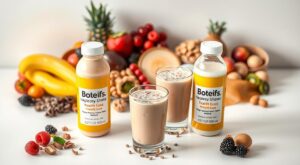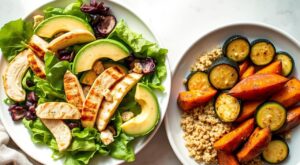Have you ever thought about mixing vegan eating with the ketogenic lifestyle? Starting a plant-based keto diet can seem tough. But, the right plan for beginners is here to help you on this journey. You’ll see how a vegan keto diet works and focus on healthy, low-carb foods.
As you start this plant based ketogenic meal plan, you’ll make tasty meals that meet your health needs. You’ll learn to question old dieting ideas and find a way to eat that’s good for you and the planet!
Understanding the Plant-Based Keto Diet
The plant-based keto diet combines two powerful diets. It focuses on low carbs and high healthy fats and plant proteins. This diet uses plant foods to promote health and keep carbs low. Knowing what the plant-based keto diet is is key to adopting it.
What is the Plant-Based Keto Diet?
The plant-based keto diet cuts down on carbs a lot. It uses plant-based fats and proteins instead. Foods like veggies, nuts, seeds, and non-dairy items are common. It helps with weight and energy without animal products.
Benefits of Going Plant-Based on Keto
Switching to this diet has many benefits. People often feel more energetic, have better digestion, and lose weight. It also boosts mental clarity and health. Plant foods offer essential nutrients, while fats from avocados and nuts keep you full.
Key Nutrients to Focus On
To do well on a vegan keto diet, focus on key nutrients. Beans, lentils, and tofu are good protein sources. Nuts and seeds provide healthy fats. Leafy greens and chia seeds add fiber for digestion.
Make sure to get vitamins B12, D, and omega-3s. You might need fortified foods or supplements for these.
Essential Ingredients for Your Keto Pantry
To thrive on a plant-based keto diet, you need the right pantry items. A smart selection ensures tasty and healthy meals. Here’s what to add to your plant based keto grocery list.
Low-Carb Vegetables You Should Stock Up On
Low-carb veggies are key to your plant-based keto diet. They’re full of fiber and nutrients, yet low in carbs. Some top choices include:
- Broccoli
- Spinach
- Zucchini
- Cauliflower
- Kale
- Bell peppers
Plant-Based Protein Sources
Quality protein is essential for energy and muscle health. Choose these plant-based options:
- Lentils
- Chickpeas
- Tofu
- Tempeh
- Quinoa
Healthy Fats to Include
Healthy fats are vital for a keto diet. They keep you full and balance your meals. Make sure to include these in your pantry:
- Avocados
- Nuts and seeds
- Coconut oil
- Olive oil

Crafting Your Weekly Meal Plan
Creating a plant based low carb meal plan can make your journey easier. It’s important to have a variety of meals. This ensures you get all the nutrients you need. Below is a sample one-week keto menu with different plant-based options. Plus, some meal prepping tips to keep you on track.
Sample One-Week Keto Menu
| Day | Breakfast | Lunch | Dinner |
|---|---|---|---|
| Monday | Avocado Smoothie | Zucchini Noodles with Pesto | Stuffed Bell Peppers |
| Tuesday | Chia Seed Pudding | Cauliflower Rice Stir-Fry | Eggplant Lasagna |
| Wednesday | Tofu Scramble | Cabbage Salad with Tahini Dressing | Portobello Mushroom Burgers |
| Thursday | Berry Smoothie Bowl | Gray Kelp Noodles Salad | Vegetable Curry |
| Friday | Savory Oatmeal with Spinach | Broccoli and Almond Salad | Stuffed Acorn Squash |
| Saturday | Plant-Based Yogurt | Mixed Greens with Sunflower Seeds | Grilled Tofu Skewers |
| Sunday | Almond Flour Pancakes | Avocado and Tomato Salad | Vegetable Stir-Fry with Tempeh |
Tips for Meal Prepping Successfully
Effective meal prepping tips can make your meal plan organized and fun. Here are some steps to get you started:
- Batch Cooking: Cook large portions of meals for the week. This saves time and adds variety to your meals.
- Organize Your Meals: Use clear containers for individual portions. Label them with meal names and dates to keep them fresh.
- Plan Ahead: Set aside time each week to plan your meals. This reduces stress and helps you stay on track.
- Incorporate Variety: Try new recipes to avoid meal fatigue. New dishes keep your diet exciting and keto-friendly.
- Snack Prep: Prepare healthy, low-carb snacks in advance. Portion control is key to staying on track.

Delicious Plant-Based Keto Recipes
Many people enjoy the plant-based keto diet because of its tasty recipes. This section offers great meal ideas for every time of day. You can enjoy vegan keto recipes for beginners and stay full all day.
Breakfast Ideas to Start Your Day Right
Start your day with a vibrant vegan keto smoothie bowl or creamy chia seed pudding. These dishes are packed with nutrients and low in carbs. Try almond flour pancakes with fresh berries or avocado toast on low-carb bread for a tasty breakfast.
Satisfying Lunch Recipes
For lunch, make a hearty salad with greens, nuts, and avocado. Grain bowls with quinoa, steamed veggies, and a zesty dressing are also great. These meals are perfect for using fresh, colorful ingredients in your plant based keto recipes.
Quick Keto Snacks on the Go
Stay full with quick keto snacks. Make nut bars with almonds and coconut flakes, or enjoy veggie sticks with hummus. These snacks are great for busy days and fit well with vegan keto recipes for beginners.
Dinner Options You’ll Love
End your day with delicious dinner options. Try stir-fried tofu with low-carb veggies or zucchini noodles in a rich tomato sauce. These meals are easy to make and highlight the creativity of plant-based keto cooking.
How to Transition to a Plant-Based Keto Lifestyle
Switching to a plant-based keto lifestyle needs careful planning. You might ask, “How do I start a plant-based keto diet?” Begin by clearing out high-carb foods and adding low-carb plant options. This method helps your body adjust gradually, making the transition smoother.
Tips for a Smooth Transition
Here are some tips to help you along the way:
- Start by slowly cutting down on carbs and adding more plant-based foods.
- Try vegan keto recipes that are high in healthy fats and proteins.
- Drink plenty of water and consider taking electrolyte supplements to avoid keto flu.
- Plan your meals in advance to stay on track with your new diet.
- Join others who are also transitioning to a plant-based diet for support and ideas.
Common Challenges and How to Overcome Them
You might face some hurdles during your transition. Here’s how to tackle them:
- Keto flu: Symptoms like fatigue and irritability can be helped by more electrolytes and rest.
- Cravings for non-plant foods: Find tasty plant-based alternatives to satisfy your cravings.
- Social situations: Prepare for dining out or gatherings by bringing your own food.

Tracking Your Progress on the Plant-Based Keto Diet
Starting a plant-based keto diet is exciting. Keeping track of your progress makes it even better. Using keto apps helps you monitor your food and nutrients easily.
Recommended Apps and Tools
Choosing the right tools is key. MyFitnessPal and Cronometer are great for tracking food and nutrients. You can also try Keto Cycle for tracking macronutrients and more.
How to Measure Success
Success in a plant-based keto diet isn’t just about weight loss. Watch for better energy, mood, and body measurements. Keeping a journal helps you see how you feel with these changes.
Regular weigh-ins and tracking nutrients keep you motivated. This way, you stay on track and feel good about your progress.

Importance of Staying Hydrated on Keto
Staying hydrated is key when you’re on keto. It helps with digestion, energy, and overall health. Knowing how much water to drink is important as your body adjusts to the diet.
Water Intake Guidelines
On a plant-based keto diet, you might need more water than usual. Aim for at least 8 cups (64 ounces) a day. But, your needs can change based on how active you are and the weather.
- Check your urine color; it should be pale yellow.
- Drink more water in hot weather or when you’re very active.
- Think about adding electrolytes to replace what you lose from diet changes.
Best Hydration Practices
Here are some tips to stay hydrated on a plant-based keto diet:
- Herbal Teas: Try caffeine-free herbal teas for flavor and hydration.
- Electrolyte-Infused Water: Use mixes to keep hydrated and get the nutrients you need.
- Fruits and Vegetables: Eat water-rich foods like cucumbers and watermelon.
By following these tips, you can enjoy your plant-based keto diet while staying hydrated.
Socializing and Eating Out on a Plant-Based Keto Diet
Dining out on keto can seem tough, but it’s doable with a plant-based diet. A bit of prep and the right strategies help you enjoy social events without giving up on your diet. Learning to read menus and ask for what you need is essential for great dining experiences.
Tips for Dining Out
Start by finding restaurants with vegan options. Here are some tips for dining out:
- Research restaurants in advance. Look up menus online to find places that offer plant-based choices.
- Don’t hesitate to ask for modifications. Swap high-carb items for veggies or ask for dressings on the side.
- Share dishes with friends. This way, you can try different foods while keeping carbs low.
- Be assertive but polite. Most places are willing to make dietary adjustments for you.
Navigating Social Gatherings
Planning is key for social events where food is a big deal. Here are some tips:
- Bring a dish to share. Make a keto-friendly, plant-based dish so you have something to eat.
- Communicate with your host. Tell them about your diet so they can prepare something for you.
- Focus on drinks. Choose keto-friendly drinks like sparkling water or herbal tea if food is limited.
- Enjoy the company. Remember, the people you’re with are just as important as the food.
Adapting to keto dining or social events is possible with careful planning and flexibility. Enjoy your meals and stay true to your health goals with these tips for eating out.
Troubleshooting Common Issues
Starting a plant-based keto diet can be tough, but it gets easier with time. You might face keto flu symptoms and cravings. It’s important to tackle these problems to succeed. Here are some tips to help you overcome these challenges.
Dealing with Keto Flu
Keto flu can make you feel tired, have headaches, and feel irritable. Your body is adjusting to using fat for energy. Here are some ways to lessen these symptoms:
- Increase your electrolyte intake: Eat foods high in potassium, magnesium, and sodium to replace lost nutrients.
- Stay hydrated: Drink lots of water to fight fatigue and stay healthy.
- Gradually reduce carbs: Slowly cut down on carbs to make the transition smoother.
Managing Cravings on Plant-Based Keto
Cravings can happen as your body gets used to the new diet. Here are some tips to manage cravings:
- Incorporate satisfying snacks: Try nut butters, avocado, or chia pudding to keep hunger at bay.
- Plan meals ahead: Having a meal plan can prevent impulsive eating.
- Stay mindful: Be aware of your cravings and figure out if they’re emotional or physical.
Building a Support System
Starting a plant-based keto diet is a big change. Having a supportive community can really help. You can find others who face the same challenges and celebrate the same wins. Look for local meetups, workshops, or online groups focused on plant-based keto.
Online forums and social media groups are great for advice and encouragement. Sites like Facebook and Reddit have many groups sharing tips and recipes. Being part of these communities can help you make friends and stay motivated.
Don’t forget to use resources like books, podcasts, and websites for vegan keto cooking. They can teach you new things and give you meal ideas. With the right information and people, you’ll do great on your plant-based keto journey.














